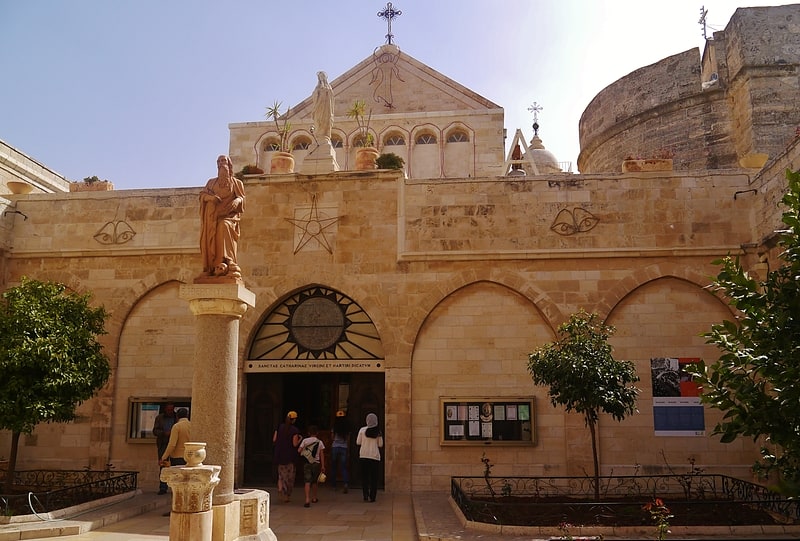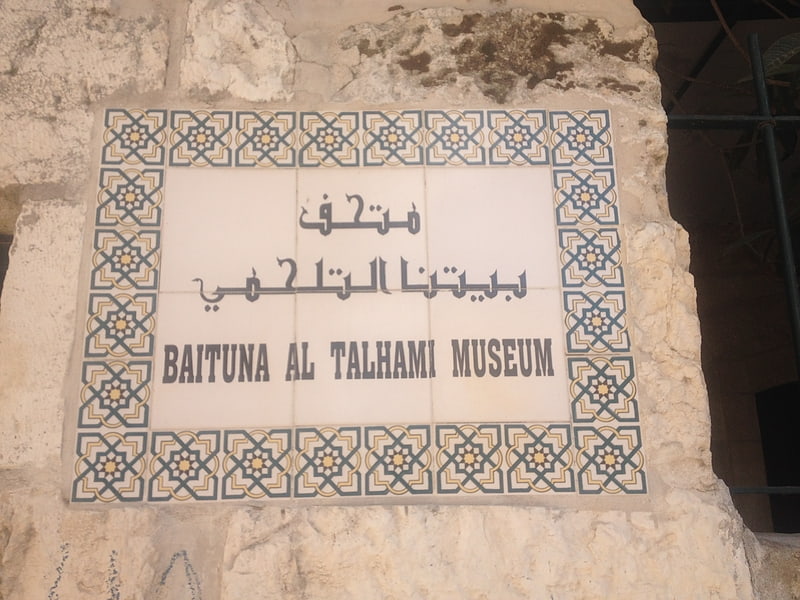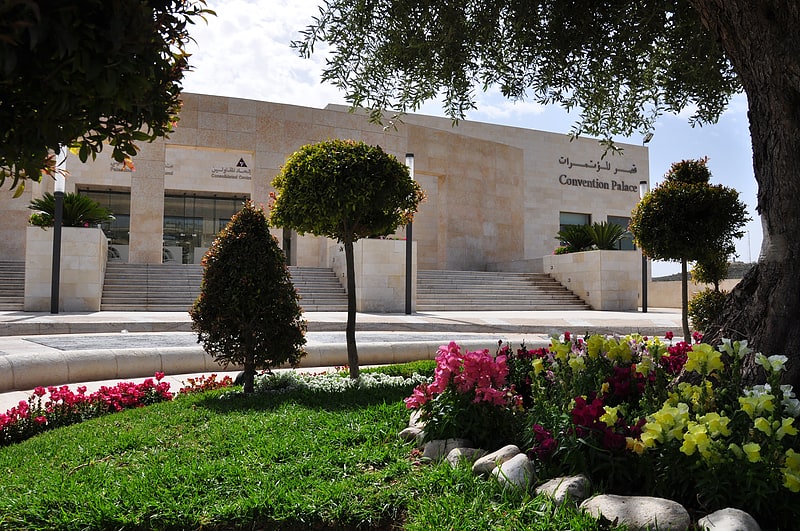Discover 11 hidden attractions, cool sights, and unusual things to do in Bethlehem (Israel). Don't miss out on these must-see attractions: Church of the Nativity, Mar Saba, and Rachel's Tomb. Also, be sure to include Church of Saint Catherine in your itinerary.
Below, you can find the list of the most amazing places you should visit in Bethlehem (West Bank).
Table of Contents
Church of the Nativity

Also known as: כנסיית המולד
Storied, ancient 4th-century church. The Church of the Nativity, or Basilica of the Nativity, is a basilica located in Bethlehem in the West Bank, Palestine. The grotto it contains holds a prominent religious significance to Christians of various denominations as the birthplace of Jesus. The grotto is the oldest site continuously used as a place of worship in Christianity, and the basilica is the oldest major church in the Holy Land.
The church was originally commissioned by Constantine the Great a short time after his mother Helena's visit to Jerusalem and Bethlehem in 325–326, on the site that was traditionally considered to be the birthplace of Jesus. That original basilica was likely built between 330 and 333, being already mentioned in 333, and was dedicated on 31 May 339. It was destroyed by fire during the Samaritan revolts of the sixth century, possibly in 529, and a new basilica was built a number of years later by Byzantine Emperor Justinian (r. 527–565), who added a porch or narthex, and replaced the octagonal sanctuary with a cruciform transept complete with three apses, but largely preserved the original character of the building, with an atrium and a basilica consisting of a nave with four side aisles.
The Church of the Nativity, while remaining basically unchanged since the Justinianic reconstruction, has seen numerous repairs and additions, especially from the Crusader period, such as two bell towers (now gone), wall mosaics and paintings (partially preserved). Over the centuries, the surrounding compound has been expanded, and today it covers approximately 12,000 square meters, comprising three different monasteries: one Roman Catholic, one Armenian Apostolic, and one Greek Orthodox, of which the first two contain bell towers built during the modern era.
The silver star marking the spot where Christ was born, inscribed in Latin, was stolen in October 1847 by Greek monks who wished to remove this Catholic item. Some assert that this was a contributing factor in the Crimean War against the Russian Empire. Others assert that the war grew out of the wider European situation.
Since 2012, the Church of the Nativity is a World Heritage Site and was the first to be listed by UNESCO under 'Palestine'.
A 250-year-old understanding among religious communities, the Status Quo, applies to the site.[1]
Address: Manger Sq., Bethlehem
Mar Saba

Also known as: מנזר מר סבא
Monastery. The Holy Lavra of Saint Sabbas, known in Arabic and Syriac as Mar Saba and historically as the Great Laura of Saint Sabas, is a Greek Orthodox monastery overlooking the Kidron Valley in the Bethlehem Governorate of Palestine, in the West Bank, at a point halfway between Bethlehem and the Dead Sea. The monks of Mar Saba and those of subsidiary houses are known as Sabaites.
Mar Saba is considered to be one of the oldest continuously inhabited monasteries in the world, and it maintains many of its ancient traditions. One in particular is the restriction on women entering the main compound. The only building that women can enter is the Women's Tower, near the main entrance.[2]
Address: Juda Desert, Bethlehem
Rachel's Tomb

Also known as: קבר רחל
Place of worship. Rachel's Tomb is the site revered as the burial place of the matriarch Rachel. The site is also referred to as the Bilal bin Rabah mosque. The tomb is held in esteem by Jews, Christians, and Muslims.
The tomb, located at the northern entrance of Bethlehem, is built in the style of a traditional maqam; Arabic for shrine. The burial place of the matriarch Rachel as mentioned in the Jewish Tanakh, the Christian Old Testament and in Muslim literature is contested between this site and several others to the north. Although this site is considered unlikely to be the actual site of the grave, it is by far the most recognized candidate.
The earliest extra-biblical records describing this tomb as Rachel's burial place date to the first decades of the 4th century CE. The structure in its current form dates from the Ottoman period, and is situated in a Christian and Muslim cemetery dating from at least the Mamluk period. When Sir Moses Montefiore renovated the site in 1841 and obtained the keys for the Jewish community, he also added an antechamber, including a mihrab for Muslim prayer, to ease Muslim fears. According to the 1947 United Nations Partition Plan for Palestine, the tomb was to be part of the internationally administered zone of Jerusalem, but the area was ruled by Jordan, which prohibited Jews from entering the area. Following the Israeli occupation of the West Bank in 1967, though not initially falling within Area C, the site has come under the control of the Israeli Ministry of Religious Affairs.
Following Montefiore's purchase of the site it began to take special "cultic" significance amongst Jews in the area; in contemporary Israeli society it is now considered the third holiest site in Judaism and has become one of the cornerstones of Jewish-Israeli identity. According to Genesis 35:20, a mazzebah was erected at the site of Rachel's grave in ancient Israel, leading scholars to consider the site to have been a place of worship in ancient Israel. According to Martin Gilbert, Jews have made pilgrimage to the tomb since ancient times. According to Frederick Strickert, the first historically recorded pilgrimages to the site were by early Christians, and Christian witnesses wrote of the devotion shown to the shrine "by local Muslims and then later also by Jews"; throughout history, the site was rarely considered a shrine exclusive to one religion and is described as being "held in esteem equally by Jews, Muslims, and Christians".
Following a 1929 British memorandum, in 1949 the UN ruled that the Status Quo, an arrangement approved by the 1878 Treaty of Berlin concerning rights, privileges and practices in certain Holy Places, applies to the site. In 2005, following Israeli approval on 11 September 2002, the Israeli West Bank barrier was built around the tomb, effectively annexing it to Jerusalem; Checkpoint 300 – also known as Rachel's Tomb Checkpoint – was built adjacent to the site. A 2005 report from OHCHR Special Rapporteur John Dugard noted that: "Although Rachel's Tomb is a site holy to Jews, Muslims and Christians, it has effectively been closed to Muslims and Christians." On October 21, 2015, UNESCO adopted a resolution reaffirming a 2010 statement that Rachel's Tomb was: "an integral part of Palestine." On 22 October 2015, the tomb was separated from Bethlehem with a series of concrete barriers.[3]
Church of Saint Catherine

The Church of Saint Catherine or Chapel of Saint Catherine is a religious building that is affiliated with the Catholic Church and is located adjacent to the northern part of the Basilica of the Nativity in Bethlehem in the West Bank in the Palestinian territories. It works as a parish church and Franciscan monastery. There is a complex of caves underneath the church.
Is administered by the Latin Patriarchate of Jerusalem, follows the Roman Rite, and is included in the UNESCO World Heritage List since 2012 as part of the "Birthplace of Jesus: Church of the Nativity and the Pilgrimage Route in Bethlehem".[4]
St. George's Monastery

Monastery. The Saint George's Monastery in Al-Khader or Church of Saint George is an Eastern Orthodox Christian monastery in the Palestinian town of al-Khader, near Beit Jala and Bethlehem in the central West Bank. The town of Al-Khader is named after Saint George, who in Arab culture is known as "al-Khadr."
According to local tradition, Saint George was imprisoned in the town of al-Khader where the current Monastery of St. George stands. The chains holding him were relics that were said to hold healing power.[5]
Baituna al-Talhami Museum

Baituna al-Talhami Museum or the Bethlehem Folklore Museum is one of the largest museums in the Palestinian territories. It is located in Bethlehem, on Star Street, slightly off Pope Paul VI Street.
It was originally set up by the Arab's Women Union (AWU) in 1948, under Julia Dabdoub, as a center for Palestinian refugees fleeing their villages to eat, and practice in traditional embroidery for income. The AWU established the museum in 1979. It consists of two houses of typical Palestinian architecture, which include a renovated kitchen, a diwan room, a bedroom and an upper floor or illeyeh. The contents of the museum included a collection of traditional Palestinian household items displayed in an old house. The amount of items increased after a campaign amongst Bethlehem's prominent families to donate their traditional belongings commenced. Many items were thus saved from withering away in the basements of homes.
In 1984, the museum was expanded to include an adjacent old house which had been restored. This new house, according to Julia Dabdoub, "is one of the few authentic old houses left in Bethlehem… similar to the house in which Jesus was born." In 1992, Dabdoub donated her forty-year collection of photographs, furniture, and works of art to furnish the upper room or "al-Illiyeh" which shows the life of Bethlehem residents between 1900 and 1932.
Although Baituna al-Talhami is run as a museum, it still serves and employs refugees, as well as host festivals celebrating Palestinian artists, poets and writers.[6]
Chapel of the Milk Grotto

Also known as: מערת החלב
Chapel. The Chapel of the Milk Grotto of Our Lady also called Grotto of Our Lady or Milk Grotto, is a Catholic chapel in Bethlehem in the West Bank of the Palestinian Territories, erected in 1872. Since Byzantine times, the place has been a center of Christian pilgrimage, maintained since its last erection together with its Marian shrine and monastery by the Custody of the Holy Land of the Order of the Friars Minor of the Catholic Church in Palestine. The Status Quo, a 250-year-old understanding between religious communities, applies to the site.[7]
Address: Close to Manger Square, Bethlehem
Mosque of Omar

Mosque. The Mosque of Omar is the only mosque in the Old City of Bethlehem, Palestine. It is located on the west side of Manger Square, across the square from the Church of the Nativity.[8]
The Shepherd's Field

Also known as: כנסיית שדה הרועים
Chapel. The Shepherds' Field Chapel is a Roman Catholic religious building. in the area of Beit Sahour, southeast of Bethlehem in the West Bank in Palestine. The chapel marks the place where, according to Catholic tradition, angels first announced the birth of Christ.[9]
Solomon's Pools

Also known as: בריכות שלמה
Archaeological site. Solomon's Pools are three ancient reservoirs located in the south-central West Bank, immediately to the south of al-Khader, about 3.5 kilometres southwest of Bethlehem, near the road to Hebron.
Solomon's Pools supplied water to Jerusalem and the Second Temple, as well as the desert fortress of Herodium. Although the site is traditionally associated with King Solomon, modern dating techniques put the construction of the oldest, extant part to the Hasmonean period between mid-second and mid-first century BCE. The construction was completed by Herod in connection with his rebuilding program of the Second Temple.[10]
Bethlehem Convention Palace

Bethlehem Convention Palace or Convention Palace Company is a convention center facility in Bethlehem, Palestine.
The building includes a main meeting hall, exhibition gallery, theatre, meeting rooms, gardens, interfaith prayer room and cafeteria. There is also a large amphitheater that can host nearly 1,500 people.
Neighboring landmarks are Qal'at Murad (Murad's Castle) and Solomon's Pools.[11]